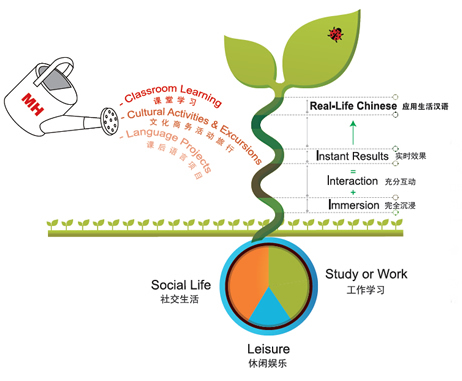Do you think Chinese is a difficult language to learn?
At Mandarin House, we are certainly aware of the challenges our students may face, from our experience, then through our unmatched teaching staff and updated learning materials, you will find Mandarin is not so difficult and you will be speaking Chinese before you know it!
Our intensive courses have been carefully designed from the ground-up, basing the curriculum and personal teaching approach around modern pedagogy methods and the valuable feedback recieved from our countless students, teachers and education department.
Mandarin House Intensive Mandarin Course
Comprehensive 30
Cover listening, speaking, reading and writing; the 4 building blocks of language learning and build a strong foundation to master your Chinese skills! The Comprehensive 30 intensive course will allow you to focus on real-life Chinese conversational skills and the reading and writing of Chinese characters.
Conversational 20
A great choice to learn the communication essentials of Chinese pinyin, listening and speaking skills, giving you confidence to speak Chinese after the very first lesson! 4 interactive group classes every morning focusing on practical Chinese conversational skills and giving you the rest of the day to practice what you learnt in your own time.
Reading & HSK
Characters are an essential part of Chinese culture and by learning them you get a deeper understanding of the language. Take the lunge and look long-term with your Chinese. Learn to read, write and understand some of the mysteries behind a writing system that is
Total Beginners Start Dates| Non-beginners can join us on any Monday
2019 |
28 Jan | 4 Mar | 1 Apr | 29 Apr |
27 May | 24 Jun | 22 Jul | 19 Aug |
16 Sep | 21 Oct | 18 Nov | 16 Dec |
Comprehensive 30
Do you want to make the most of your time in China? The Comprehensive 30 intensive course will allow you to focus on real-life Chinese conversational skills and the reading and writing of Chinese characters.
Small group classes sharing your level will give you friendly competition, while allowing you to get full attention from the teachers.
With 6 lessons every day, you will get the complete Chinese training to fully prepare you for your academic or professional career.
Register now for a great opportunity to make international friends, learn with other like-minded people and greatly improve your Chinese.
Course Benefits
6 group lessons a day from Monday to Friday
30 language lessons a week
Learn listening, speaking, reading and writing
Small classes, maximum 10 students and minimum 3 students
45 minutes per lesson
Minimum age 16 years old
International student mix
Flexible intake and start dates
Conversational 20
A great choice to learn the communication essentials of Chinese pinyin, listening and speaking skills.
4 interactive group classes every morning focusing on practical Chinese conversational skills and giving you the rest of the day to practice what you learnt in your own time.
Surrounded in an international environment, you will be placed at your level in a group class. You will benefit from group class interaction, while getting personalised attention from the teacher. You will not learn quicker or better anywhere else!
Register now and start speaking Chinese after the very first lesson.
Course Benefits
4 group lessons a day
20 language lessons a week
Learn real-life conversational skills
Small classes, maximum 10 students and minimum 3 students
International student mix
Minimum age 16 years old
45 minutes per lesson
Flexible intake and start dates
Reading & HSK
你会读写中文吗? Can you read and write Chinese?
Characters are an essential part of Chinese culture and by learning them you get a deeper understanding of the language and in the long term helps you master Chinese faster as not only can you read Chinese magazines, maps,
Reading & HSK books etc., but your mind is able to make an extra association and stronger connections with words. Not only that, but it makes calligraphy and playing mahjong much easier!
Also, learning characters is essential if you are planning to enter a Chinese university or take the HSK exam.
Our Reading & Writing 10 Chinese course consists of 2 afternoon lessons every day in an interactive group class made up of students from across the globe to learn this ancient language format.
Course Benefits
2 group lessons a day from Monday to Friday
10 language lessons a week
Learn reading and writing Chinese characters
Small classes, maximum 10 students and minimum 3 students
45 minutes per lesson
Minimum age 16 years old
International student mix
Flexible intake and start dates
Learn mandarin in China?Mandarin House will be your best chioce!
The Mandarin House DIFFERENCE:“Immersive Learning Experience”

“Growing your Chinese the MH Way”
“At Mandarin House you will be able to speak better Chinese from the first class! Our students are always amazed at how fast they learn!”
美和汉语“沉浸式学习法”


